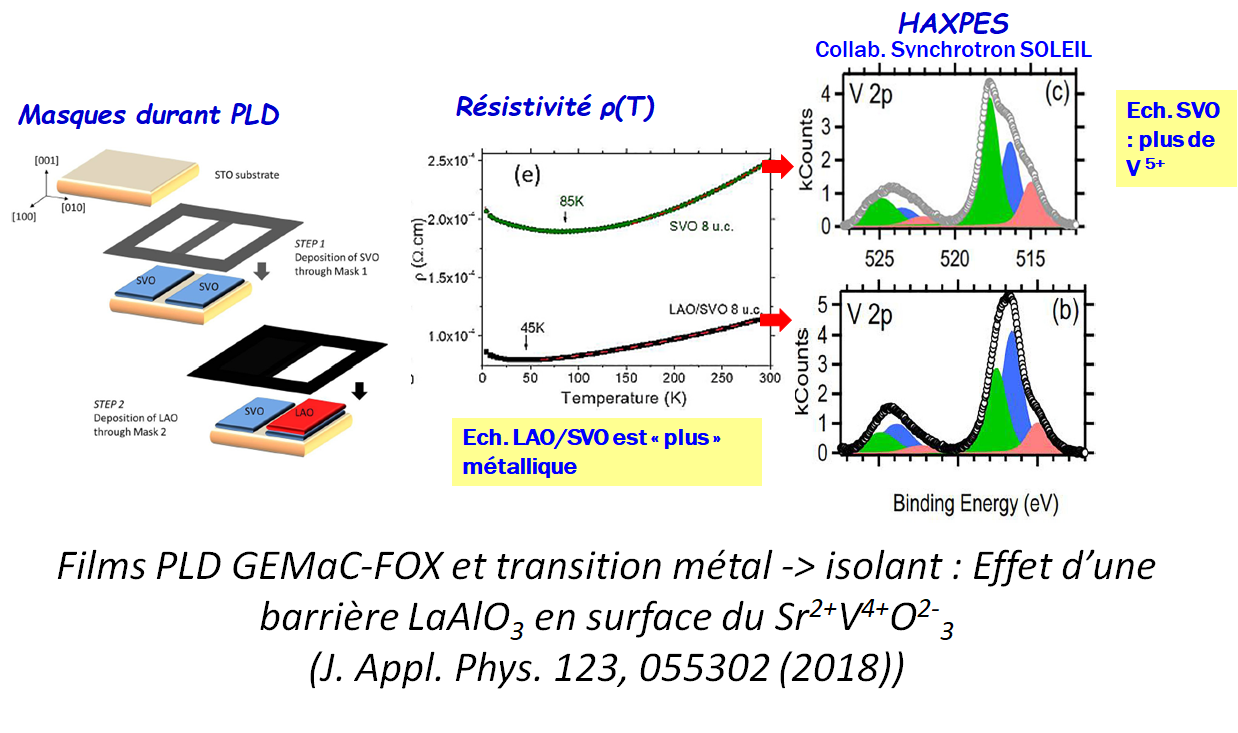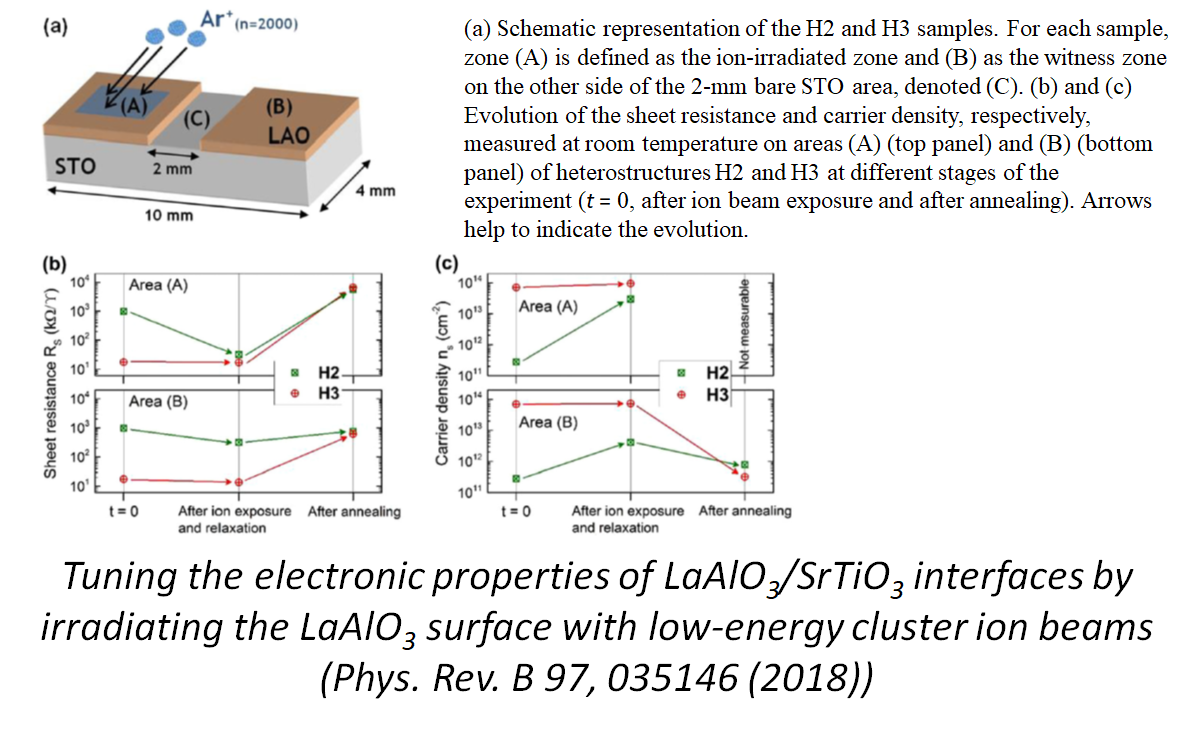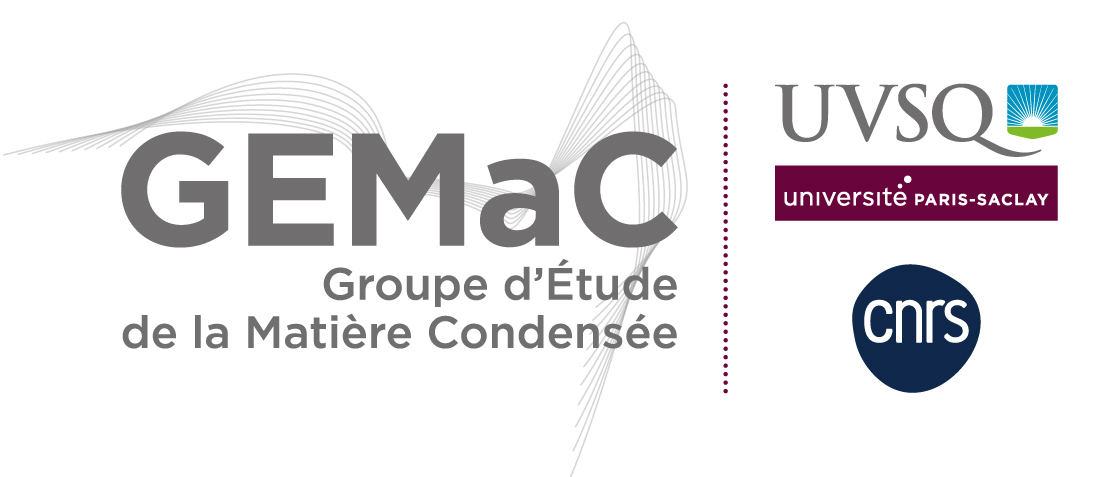We also focus on electronic
transport properties of these (3d, 4f) transition metal ternary oxides (resistivity, magnetoresistance, ordinary and extraordinary Hall effect) and have developed unique
high impedance magneto-transport measurements over a wide temperature and magnetic field range. This allows us to quantify the semiconductor and/or spin-carrier coupling properties in these systems usually possessing low mobility or very localized carriers.
Using the available equipment, we can accurately probe the metal-insulator transition in metallic systems such as vanadates (AVO3) or nickelates (ANiO3) as a function of the following parameters: the thickness of the films reduced to a few atomic layers, the oxygen vacancy concentration, and the stress induced by the interfaces. Thus, in these metallic systems with very high carrier concentrations (1e+22 to 1e+23 cm-3), the source of new properties is linked to the very strong electronic correlations associated with 3d (or 4f) electrons, opening up "functions" for tomorrow's electronics that are non-existent in conventional semiconductors. We then speak of "Orbitronics", when the properties are associated with the specificity of chemical Metal-Oxygen (2p) bonds; or "Mottronics", when it is a question of quantum effects linked to the opening of a gap associated with the very strong electron correlations of 3d, 4f electrons, due to the reduction of dimensionality in one direction. Topological effects are predicted in the (111) direction of perovskites, in bilayer or superlattice, with conductive nickelate, vanadate, or interface electron gas.
Currently, we are focusing on :
a. Ultrathin 3d transition metal perovskite oxides: example of LaNiO3 and SrVO3

The influence of oxygen stoichiometry on the electronic structure of LaNiO3 was studied by
magneto-transport,
X-ray diffraction and
ion analysis in thin and ultra-thin films. Strontium vanadate (SrVO3 or SVO) also exhibits a metal-insulator transition (MIT) as a function of dimensionality. In this system, the MIT at low temperature is due to a renormalization of the electron-electron interactions, resulting in low anti-localization and MIT phase transition for thicknesses < 6 nm. When an ultra-thin film of SVO with a thickness of 4 elementary cells is covered by a polar diffusive barrier layer of LaAlO3 (LAO), this heterostructure shows a minimum resistivity at 250 K. A photoemission spectroscopy study using hard X-rays at the
SOLEIL synchrotron (coll. J.-E. Rault, J.-P. Rueff) revealed that the surface oxidation state of vanadium for SVO is rather 5+ due to a surface oxidation inhibited by the LAO layer.
The SVO system is also a model for the Mott MIT study, linked to strong electronic correlations as demonstrated by the comparative photoemission study on samples (
including those made by FOX) at different oxygen vacancy concentration (coll. A. Santader-Siro of the
CSNSM). Studies are continuing with local physico-chemical measurements by XPS with soft thickness profiling (coll. D. Aureau, M. Frégnaux,
CEFS2-ILV) to study the SVO conductive "brick" in view of integration in nanometric electronic devices.
b. Two-dimensional electronic gas at the STO/LAO interface

In the light of the debate on the origin of the archetypal two-dimensional electron gas at the interface between the very good semiconductor SrTiO3 (STO) and the insulator LaAlO3 (LAO), we have grown these materials by
PLD and focused our studies on the physico-chemistry and valence at the interface thanks to the collaboration with the X-ray photoelectron spectroscopy (XPS) specialists of the
CEFS2 platform where it is possible to perform the thickness profiling by argon cluster erosion. Combining valence spectroscopy on Sr, Ti and O ions with the study of
electron transport, we have investigated the difference in the erosion by Ar cluster in comparison to an Ar+ single atom ion beam on the STO surface, either free or buried under the LAO.
Our expertise and instrumental development in
magneto-transport of weakly conductive systems (such as low mobility oxides, but also semiconductor systems with very large gap and deep acceptor/donor levels) make it natural for us to collaborate with the "large gap semiconductors" teams of GEMaC. Together, we work on the quantification of conductivity, mobility and carrier concentration: with the
DIAM team on n-type phosphorus doping, and with the
NSP team on the study of doped p-type gallium oxide Ga2O3.






 The influence of oxygen stoichiometry on the electronic structure of LaNiO3 was studied by
The influence of oxygen stoichiometry on the electronic structure of LaNiO3 was studied by  In the light of the debate on the origin of the archetypal two-dimensional electron gas at the interface between the very good semiconductor SrTiO3 (STO) and the insulator LaAlO3 (LAO), we have grown these materials by
In the light of the debate on the origin of the archetypal two-dimensional electron gas at the interface between the very good semiconductor SrTiO3 (STO) and the insulator LaAlO3 (LAO), we have grown these materials by